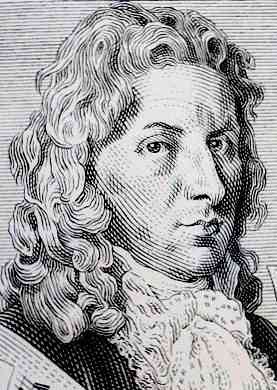


Johann Stamitz
Source: Find a Grave
Born on 18 June 1717 in Deutschbrod, Bohemia, Johann Stamitz was a Czech composer who, though Bohemian, would spend the most noteworthy part of his career in Bavaria. Despite his death at a young age Stamitz became of major significance in the development of early classical composition and orchestration, both as an innovator among his contemporaries as the major force of the Mannheim school, and of long-lasting interest to such as Joseph Haydn thirty years his younger and W.A. Mozart born the year before Stamitz' passing in 1757. It was during Stamitz' period that Bohemian (Czech) composers began to make their presence known amidst the rest of Europe and Russia, arriving relatively late, but now soundly and in number via the contributions of not a few of Stamitz' contemporaries henceforward such as Karel Kopřiva, Jan Křtitel Kuchař and Josef Myslivecek.
The Mannheim school of 1720 to 1781 much represents the time period when late baroque gradually shifted into classical with galant in between. "Galant" originated as a term at the court of Louis XIV, not defining a style so much as a taste to be preferred as in the latest manner. Today's "passé" was yesterday's galant as liberties were taken with baroque form that had served just fine up until now for the last century. The Manheim school was located in the Electoral Palatinate along the Rhine River governed by an Elector Count or Elector Palentine, that being Elector of Bavaria, Charles Theodore, at Stamitz' time. That is, the Mannheim school was Catholic in sympathy as part of the Holy Roman Empire rather than Protestant. It had originated with the Mannheim Hofkapelle (court orchestra) which was a large fifty-member fusion of orchestras discontinued at Innsbruck and Düsseldorf. Stamitz would become director of this force in 1750 though probably didn't write anything for so large an orchestra. In the meantime he left behind works like 58 symphonies, 10 orchestral trios and a number of concertos for various instruments.
Stamitz had studied at the University of Prague in 1734/35 before quitting to play the violin, as he was virtuosic with the instrument. His activities for the next several years are largely unknown before he emerged at the Court of Mannheim circa 1741. It was sometime between 1741 and 1746 that his Mannheim symphonies No.1, No.2 and No.3 were written. What was once thought to be his No.1, however, is now considered more likely to be by Antoine Mahaut, making his No.2 or No.3 his first symphony. Stamitz later wrote symphonies in four movements, but these are in three:
'Mannheim Symphonies' Nos.1-3 Johann Stamitz
Mannheim Symphony No.1 in G major
Mannheim Symphony No.2 in A major
Mannheim Symphony No.3 in B-flat major
No.1 now thought to be composed by Antoine Mahaut
Comp sometime 1741-46
Hibiki Strings of Japan / Taras Demchyshyn Aug 2013
It was 1 July 1744 that Stamitz married Maria Antonia Luneborn, two of five children to arrive to die in infancy, two to become composers, Carl Stamitz and Anton Stamitz [Stamitz family of composers]. Johann became formal director of his Mannheim school in 1750. His Op. 1 (first work published in print, that is, book 1), 'Six Grand Orchestra Trios', was likely authored and published sometime during the fifties. Stamitz is known to have been residing in Paris by 1754 during which year he performed at a concert spirituel (public concerts given in Paris since 1725 / HOASM). Returning to Mannheim in 1755, Stamitz died two years later on 27 March 1757 only forty years of age.
'Six Grand Orchestra Trios' Op 1 Johann Stamitz
Comp c 1754-55 Pub c 1755-56
For 2 violins / basso continuo / strings
New Zealand Chamber Orchestra / Donald Armstrong 1995
Samples of Stamitz below are not in chronological order. As dates for most of Stamitz works are unknown the concertos for various instruments below are placed in alphabetical order, likely occurring sometime between his first symphonies and latter orchestral trios above. Stamitz' concerto for clarinet may be the first one ever composed for that instrument, and is his only. He also wrote only one concerto for trumpet.
Concertos
'Clarinet Concerto' B-flat major Johann Stamitz Date unknown
Academy Of St. Martin In The Fields / Iona Brown
Clarinet: Sabine Meyer
'Flute Concerto' G major Johann Stamitz Date unknown
Cologne Chamber Orchestra / Helmut Müller-Brühl
Flute: Robert Aitken
'Organ Concerto' No.2 in C major Johann Stamitz Date unknown
Dvořák Chamber Orchestra / Vladimir Válek
Organ: Alena Veselá Church of Our Lady before Týn in Prague
'Organ Concerto' No.4 in E-flat major Johann Stamitz Date unknown
Dvořák Chamber Orchestra / Vladimir Válek
Organ: Alena Veselá Church of Our Lady before Týn in Prague
'Trumpet Concerto' D major Johann Stamitz Date unknown
Academy Of St. Martin In The Fields / Sir Neville Marriner
Trumpet: Håkan Hardenberger
Sources & References for Johann Stamitz:
Robert Cummings (All Music)
VF History (notes)
Audio of Stamitz:
Classical Archives Hyperion Naxos Presto
Electoral Palatinate:
European Heraldry (heraldry)
Wikipedia (counts)
Wkipedia (counts)
Mannheim school (1720-81):
Recordings of Stamitz: Catalogs: Music Brainz
Recordings of Stamitz: Select:
Johann Stamitz Symphonies Vol. 1 (New Zealand Chamber Orchestra / Donald Armstrong)
Johann Stamitz Symphonies Vol. 2 (Northern Chamber Orchestra / Nicholas Ward)
Johann Stamitz Symphonies Vol. 3 (Musica Viva Chamber Orchestra / Alexander Rudin):
Orchestral Trios Volume I (New Zealand Chamber Orchestra / Donald Armstrong / 1995)
Scores:
Gallica (digital copies)
IMSLP
(digital copies)
Internet Archive
(digital copies)
Musicalics
(vendor)
Bibliography:
Hugo Riemann (Thematic Catalog of the Mannheim Symphony / 45 symphonies / 10 orchestra trios / 1902)
Eugene K. Wolf (The Symphonies of Johann Stamitz / WolS numbers / Scheltema & Holkema / 1981):
Rachel Wade (review)
Neal Zaslaw (review)
Other Profiles: Artaria Editions Chris Whent Wikipedia Français
Classical Main Menu Modern Recording
|
|
hmrproject (at) aol (dot) com